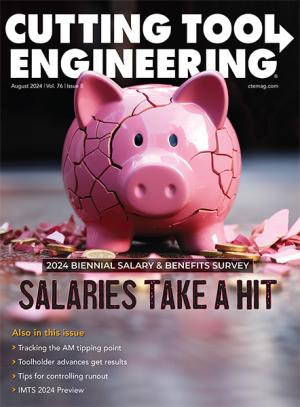Designated Project CAMPFIRE (Certified Additive Manufactured Parts Finished with Intelligent Robotics Engine), Sheffield, U.K.-based Rivelin Robotics is collaborating with five partners to deliver a digital postprocessing solution for the automated finishing of 3D-printed parts. While the parts — and the application of them — are very different in specification, there are many factors that unite these companies, not least their frustrations with the traditional operations available to them for postprocessing parts, Rivelin reports.
Presented here are insights from the five partners: C.L.&E. Attenborough Ltd. in Nottingham, U.K.; GKN Aerospace Services Ltd. in Birmingham, U.K.; Materials Solutions Ltd. in Worcester, U.K.; Saint-Gobain Abrasives in Stafford, U.K.; and Yaskawa U.K. Ltd. in Washington, U.K.
Attenborough Medical and Attenborough Dental design and manufacturer implants. CEO Ed Attenborough stated: “The postprocessing phase of metal AM implants is a major bottleneck in our overall process. As our business has grown and volumes continue to increase, finding a solution to overcome this bottleneck is imperative. Apart from the time it takes for each part with increasing volumes, other challenges include the fact that different medical implant sizes can vary and the parts themselves tend to be small, delicate and fragile. It is not uncommon for parts to break during support removal or warp due to external forces applied to the part during the manual removal process.”

GKN Aerospace is a Tier 1 supplier to the aerospace industry. Brad Hughes, principal research engineer – additive, said: “Powder bed additive manufacturing is a core part of GKN Aerospace’s long-term strategy, as we look to diversify our material supply chain, enabling us to grow our business and better serve our customers. Whilst AM has the potential to deliver multiple benefits in aerospace, from product performance to sustainability improvements, there are clear barriers to its adoption.”
Materials Solutions uses metal AM as a production method for gas turbine components. Trevor Illston, chief manufacturing engineer, said: “The major advantage of using AM is the ability to manufacture highly complex, optimized geometries that can increase the performance of the gas turbines. A good example of this is for stage 1 turbine vanes where the ability to design and manufacture highly complex internal cooling schemes has enabled vanes to be introduced with enhanced operational life, along with a significant reduction in cooling air requirements and allowed the use of more cost competitive turbine alloys.”
Saint-Gobain Abrasives has extensive experience in producing grinding wheels and other tools for manual finishing of metal parts. Gabriele De Blasio, robotics manager for abrasive applications EMEA, said: “Automation is absolutely the key for postprocessing. We have several customers worldwide working in the field of turbine blades processing, and traditionally all of those have been finished manually. That’s changing now and we are excited to be involved in this project as we witness the transition to fully automated postprocessing.”
Industrial drive and robot arm manufacturer Yaskawa also brings system integration capabilities to the collaboration. Jonny Grey, sales director, said: “Yaskawa is passionate about pushing the benefits of robotic automation to manufacturers. Through Rivelin, we see the potential for robotic postprocessing of AM parts to be increasingly adopted across many industries, even those that are highly regulated.”
Related Glossary Terms
- abrasive
abrasive
Substance used for grinding, honing, lapping, superfinishing and polishing. Examples include garnet, emery, corundum, silicon carbide, cubic boron nitride and diamond in various grit sizes.
- alloys
alloys
Substances having metallic properties and being composed of two or more chemical elements of which at least one is a metal.
- grinding
grinding
Machining operation in which material is removed from the workpiece by a powered abrasive wheel, stone, belt, paste, sheet, compound, slurry, etc. Takes various forms: surface grinding (creates flat and/or squared surfaces); cylindrical grinding (for external cylindrical and tapered shapes, fillets, undercuts, etc.); centerless grinding; chamfering; thread and form grinding; tool and cutter grinding; offhand grinding; lapping and polishing (grinding with extremely fine grits to create ultrasmooth surfaces); honing; and disc grinding.
- lapping compound( powder)
lapping compound( powder)
Light, abrasive material used for finishing a surface.
- robotics
robotics
Discipline involving self-actuating and self-operating devices. Robots frequently imitate human capabilities, including the ability to manipulate physical objects while evaluating and reacting appropriately to various stimuli. See industrial robot; robot.









